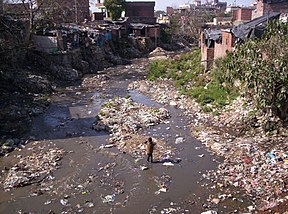Electronic waste in India
Electronic waste is emerging as a serious public health and environmental issue in India. India is the "fifth largest electronic waste producer in the world"; approximately 2 million tons of e-waste are generated annually and an undisclosed amount of e-waste is imported from other countries around the world.
India generated 708,445 tonne e-waste in 2017-18 and 771,215 tonne the following fiscal, the report estimated. In 2019-20, the figure rose 32 per cent to 1,014,961 tonne. The figures have taken into account the 21 types of electrical and electronic equipments listed in the E-Waste Management Rules, 2016.
Annually, computer devices account for nearly 70% of e-waste, 12% comes from the telecom sector, 8% from medical equipment and 7% from electric equipment. The government, public sector companies, and private sector companies generate nearly 75% of electronic waste, with the contribution of individual household being only 16%.
E-waste is a popular, informal name for electronic products nearing the end of their "useful life." Computers, televisions, VCRs, stereos, copiers, and fax machines are common electronic products. Many of these products can be reused, refurbished, or recycled. There is an upgradation done to this E-waste garbage list which includes gadgets like smartphone, tablets, laptops, video game consoles, cameras and many more. India had 1.012 billion active mobile connections in January 2018. Every year the number is growing exponentially.
*Environmental impacts:
The processes used to recycle and dispose of e-waste in India have led to a number of detrimental environmental impacts. As a result, improper recycling and disposal techniques, air, water and soil throughout much of India is now contaminated with toxic e-waste byproducts.
Air Edit
Air pollution is a widespread problem in India—nine out of the ten most polluted cities on earth are in India.[13] An important contributor to India's air pollution problem is widespread, improper recycling and disposal of e-waste.
For example, dismantling and shredding of e-waste releases dust and particulates into the surrounding air. Low value e-waste products like plastics are often burned—this releases fine particles into the air that can travel hundreds-to-thousands of miles
Wate
India's sacred Yamuna river and Ganges river are considered to be among the most polluted rivers in the world. It is estimated that nearly 80% of India's surface water is polluted.[15] Sewage, pesticide runoff and industrial waste, including e-waste, all contribute to India's water pollution problem.[15]
E-waste contaminates water in two major ways:
- Landfills: Dumping e-waste into landfills that are not designed to contain e-waste can lead to contamination of surface and groundwater because the toxic chemicals can leach from landfills into the water supply.
- Improper recycling: Improper recycling produces toxic byproducts that may be disposed of using existing drainage such as city sewers and street drains. Once these products have been introduced into the local water supply, they can cause further pollution by entering surface water such as streams, ponds, and rivers.





Comments
Post a Comment